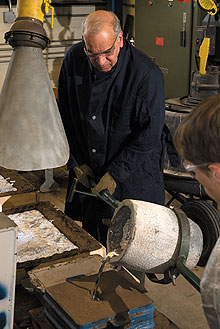  |
| HOME | THIS ISSUE | CALENDAR | GRANTS | BACK ISSUES | < BACK | NEXT > |
Former engineering dean honored for research contributionsby Nan Cooper - March 16, 2009
|
||||
| Harold Brody, Distinguished Professor of Materials Science & Engineering, was recently honored by the Minerals, Metals & Materials Society for outstanding contributions in the field of solidification science. He received the 2009 Bruce Chalmers Award during the society’s annual meeting in San Francisco in February. Research on alloys Brody’s research has focused on the solidification of alloys. To make an alloy, metallurgists may heat two or more elements to a liquid phase, mix them together at a proportion that provides a uniform solution, and transfer the molten alloy to a mold, where it solidifies in a manner that produces desired properties in the cast product. “Think of tea,” says Brody. “Hot tea accepts more sugar than iced tea, with the sugar remaining bound in solution, to a critical tipping point: the solubility limit. When sweetened hot tea is cooled, sugar crystals can begin to form as precipitates. The solid crystals are richer in sugar than the sweetened liquid tea. When we blend metals in an alloy, the alloying elements, in general, are more soluble in the liquid than the solid phase.” Brody notes that “solidification takes place over a range of temperatures, and the composition of the solid differs from the composition of the liquid from which it forms. Branched structures ” The distinctive “jack frost” that forms on windows in winter is a familiar example of dendritic crystal formation. Brody says the Chalmers Award is a very personal honor. Chalmers (1907-1990), a renowned professor of applied physics at Harvard University, is regarded as the father of solidification science. As a graduate student at MIT, Brody belonged to a research group overseen by Professor Merton Flemings, who collaborated with Chalmers.
Flemings and Chalmers regularly brought their research groups together for seminars. Brody says he was impressed by Chalmers’ skill in translating complex research into simple terms. “He was a model for what a great professor should be,” he says. “I’m probably one of the last people to receive the award who was influenced directly by Dr. Chalmers.” Brody says one of Chalmers’ principal contributions was in understanding how to solidify alloys to achieve a smooth, unbranched interface between the solid and the liquid that yields a nearly defect-free structure, providing superior properties in semiconducting and magnetic materials. Much of Brody’s work, by contrast, has focused on fostering and manipulating dendritic solidification to attain premium properties in structural materials. Automotive industry With support from an automotive consortium led by General Motors and the Department of Energy, Brody and his colleagues are developing computer-aided routines that simulate the evolution of dendritic structures. The results will be applied in the design and manufacture of high-quality components. To achieve this goal, he says, he and his team must discover and understand the behavior of complex commercial alloys and develop a practical database of the thermodynamic and kinetic properties of different materials. Brody was dean of engineering from 1991 to 1997. He joined UConn from the University of Pittsburgh, where he was a faculty member and administrator for 25 years. |
| ADVANCE HOME UCONN HOME |

